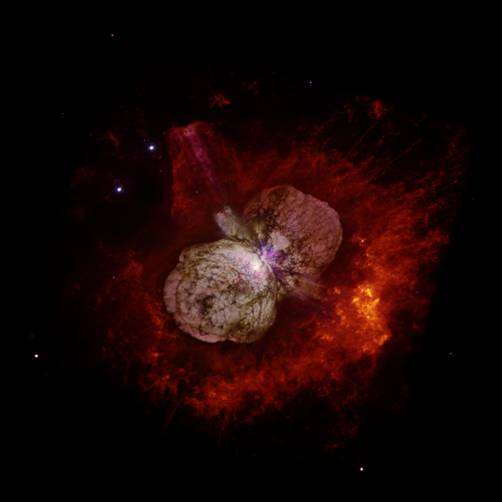SN2015bh—the end of a star or an 'impostor' supernova?

Massive stars end their lives in supernova explosions, highly energetic events that can be as luminous as the entire starlight from their host galaxies. However, there are events called "supernova impostors" which, despite their intensity, are not the end of the star's life. This could very well be the case of SN 2015bh, a star which had suffered at least 21 years of violent eruptions and which, together with a number of other objects, could be a member of a new class.
"Luminous blue variable stars like this one show two different kinds of eruptions: regular outbursts after which the star returns to its original state and giant eruptions which alter the star permanently. A prominent example is Eta Carinae, a star which has already lost mass equivalent to 40 times the mass of our Sun though winds and eruptions," says Christina Thöne, scientist at the Institute for Astrophysics of Andalucia (IAA–CSIC) and head of the HETH group (High energy transients and their hosts) who is leading the study.
Some stars suffer even larger outbursts that very much resemble real supernova explosions. The dividing line between those imposter supernovae and real ones is still a matter of debate. The case of SN 2015bh is a good example for this difficult decision about whether the explosion has ended the life of the star or not.
The turbulent chronology of SN 2015bh
Archival records show that the star had experienced frequent minor eruptions since at least 1994, alternating with quieter periods. On Feb. 10, 2015, an outburst was detected and classified as impostor supernova, which prompted a renewed interest in the star.
In April 2015 a group lead by the Institute of Astrophysics of Andalucia (IAA–CSIC) started weekly observations from different observatories observing this new outburst that started to decay slowly. This later called "precursor event" was followed by an even more intense outburst on May 16 which, instead of declining, was rising in intensity until May 24. The energy released in this so-called "main event" is compatible with the release in a real supernova.

"The vast majority of data were obtained from Spanish telescopes, in particular from the Calar Alto observatory in Almeria, the Gran Telescopio Canarias on La Palma and the Observatory of Sierra Nevada (Granada). In fact, the main event had been detected thanks to the Observatory of Sierra Nevada," says Christina Thöne (IAA-CSIC).
Subsequent observations spanning up to 200 days after the main event, show that the star has lost luminosity, and now shows bluer colors than in previous phases, but are unable to confirm that the star has exploded. In addition, the entire process turns out to be very similar to a few other events for which the death of the star could not be confirmed either until now.
"Now we know already several cases of these luminous blue variables that follow the same pattern: smaller, more or less continuous eruption over several decades and an outburst between 40 and 80 days before the main explosion. In fact, the evolution of SN 2015bh turns out to be basically a carbon copy of SN 2009ip, a famous example of a supernova impostor that took place in 2012 whose fate is still highly debated," explains Christina Thöne (IAA-CSIC).
On a fast track to the Wolf-Rayet phase
In the current theoretical framework, luminous blue variables are massive stars in a transition to a Wolf-Rayet phase, which is supposed to be the last phase of its life. But before they can enter this phase, they have to get rid of their outer envelope and the mechanism for that is still unknown: the stars can lose their envelope though very strong stellar winds, however, these winds might result being very inefficient to achieve the transition to the Wolf-Rayet phase; a single giant eruption does not seem to solve the problem either, as we see in Eta Carinae, which has already suffered at least two giant eruptions and still continues as a luminous blue variable star.
Nevertheless, a violent eruption such as SN 2015bh could be a way to fast-track the star's evolution to its last phase. If SN 2015bh and other events with similar pattern have survived this explosion, they could already be on their way to become Wolf-Rayet stars.
"SN 2015bh is not an isolated case and there are possibly many more similar objects out there that have gone unnoticed, but it seems we have encountered a new type of stellar event. Now we need to uncover the mechanism driving those events and find out why the observed cases show such very similar behavior," Christina Thöne (IAA-CSIC) concludes.
More information: C. C. Thöne et al. SN 2015bh: NGC 2770's 4th supernova or a luminous blue variable on its way to a Wolf-Rayet star?, Astronomy & Astrophysics (2017). doi.org/10.1051/0004-6361/201629968
Provided by Institute of Astrophysics of Andalusia



















